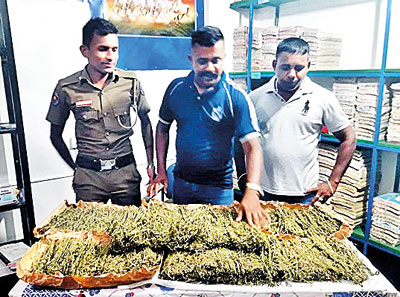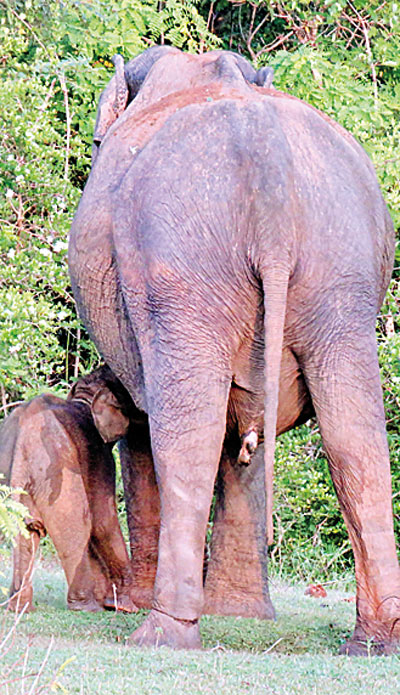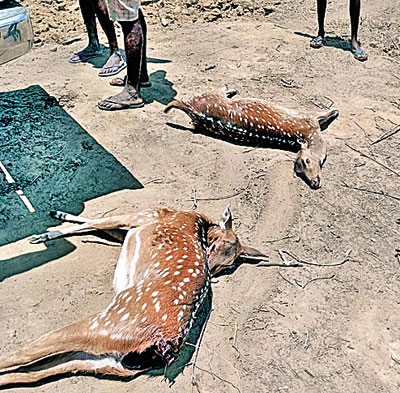News
Parts of Yala at risk from illicit ganja growers, poachers, and bushmeat trade
View(s):- With little supervision from wildlife officials, illicit activites thrive in national park’s inaccessible terrains
By Kasun Warakapitiya
Colombarachchige Princy Surendara, 39, an environment justice activist from Diulpallama in Tissmaharama, said he had informed the authorities and the police of illegal activities in the national park and even raised the issues on two occasions at the Tissamaharama divisional agriculture meeting.

Officers raiding Ganja cultivation inside Yala National Park
He said illegal activities were common at the National Park’s blocks 4, 5, and 6, as they were not open for safari tours.
Mr. Surendara said about 200 acres had been destroyed due to illegal activities and claimed that there were about 50 to 60 cannabis plantations still in the park.
He said he recently saw two cannabis cultivations one kilometre off of the Panagammana beat office. He said he brought this up at the divisional agriculture committee meeting two weeks ago, and the officials indicated that they were aware of it and assured action would be taken.
Raids were carried out by police and Wildlife Conservation Department (DWC) officers, but Mr. Surendara claimed he was not informed of the action taken against the culprits or if the cannabis plants were destroyed.
“Growing cannabis is not the only illegal activity in the park. Cannabis growers also engage in a side hustle of poaching animals for illegal bushmeat,’’ he said.

Yala ganja: Police say they carry out raids based on tipoffs
Apart from that, the poachers and cannabis cultivators use trap guns, setting wire snares targeting deer, sambar deer, and wild boar. They also place hakka pattas (jaw-breaker exploders) to kill wild boar, but elephants suffer too.
Environmentalists said that the illegal activities in the park had increased over the past three months.
Environmentalist Supun Lahiru Prakash, a researcher and convener of the Biodiversity Conservation and Research Circle, said he had noticed elephants with damaged trunks and legs. The injuries had been caused by snares.
He pointed out that illegal activity had increased after three wildlife officers were arrested and remanded on an allegation that they shot dead a poacher in block 6 of the park on November 15, 2023.
Mr. Prakash explained that after the incident, wildlife officers had reduced armed patrols within the park as a trade union action. He said that recently, tuskers had been shot at by poachers within protected areas due to a lack of action by the DWC.
He also blamed Wildlife and Forest Resource Conservation Minister Pavithra Wanniarachchi for failing to intervene in the issues faced by the DWC.
Area police officers said they undertake raids based on information.
Lunugamwehera police officer-in-charge Chithaka Wickramaratna said 13 raids had been undertaken in Yala National Park in the past two months. Some plants were collected as evidence, and the cultivation was set alight, he said.
When suspects are not caught, the police destroy the cultivation, he said.
Tissamaharama police have also raided cannabis plantations. They said that even Kataragama police had raided sites within the park.
Tissamaharama police OIC Manohara Kudagodage said he was aware of cannabis cultivations inside the park, and they had conducted six raids in the past three months and produced several suspects in court.
Mr. Kudagodage said several bush meat vendors had also been produced in court. Despite fines of Rs 10,000 to Rs 15,000, the illegal bushmeat trade continues.
Meanwhile, a senior police officer said DWC officials are responsible for protecting national parks under the Wildlife Act. However, he added that as responsible state officers, the DWC officers should inform the police of any illegal activity within the park.
The police media spokesman and Deputy Inspector General, Nihal Thalduwa, said the Special Task Force used drones to detect cannabis cultivations within Yala National Park under the ‘Yukthiya’ campaign.
Tissamahrama’s additional divisional secretary, Manoj Kodituwakku, told the Sunday Times that a whistleblower at the divisional agriculture meeting mentioned cannabis being grown within Yala National Park but had not given specifics. He said that he asked the informant for more details. Hambantota District Secretary H.P. Sumanasekara said he had not received any complaints regarding illegal activities in Yala National Park. However, when the Sunday Times told him of the whistleblower’s complaint, he checked with the Tissamaharama additional divisional secretary and confirmed it, but said the activist had not pointed out the exact locations.

“I will inform the area police, the DWC director general, and the park warden and get the support of all stakeholders to stop the illegal cannabis cultivation,’’ he said.
He said he would also ask the person who provided the information at the divisional agricultural meeting to give more details to the police.
A wildlife officer on duty in blocks 3, 4, 5, and 6 said that most cannabis cultivations were in block 3, which is inaccessible to DWC, STF, and police.
Finding the small cannabis plots scattered across the park is challenging, he said.
Yala National Park Warden Manoj Vidyaratne told the Sunday Times he had not recently received any information about cannabis cultivation in blocks 1 and 2.
He said that about two months ago, DWC officers and rangers raided cannabis cultivation near Pragammana beat office in Yala Section 1, but failed to nab the culprits.
Mr. Vidyaratne said more cannabis cultivation-related incidents were taking place at blocks 4, 5 and 6, which are handled by another officer.
DWC Director General Chandana Sooriyabandara was unavailable to comment.
| Elephants suffer most from illegal snaresIllegally-set snares tighten around wild animals that struggle to free themselves and injure them. Dr. Tharaka Prasad, director in charge of wildlife health, said elephants suffer most because their trunks get caught in snares, which cut into flesh the more they struggle. The wounded animal then suffers, unable to feed itself later. “Elephants with injured trunks change their behaviour completely; they drink water like other animals, kneeling in water tanks to sip water through their mouths,” he said. Injuries in the trunk disrupt their natural manner of feeding themselves.Dr. Prasad said the DWC has detected over 20 cases of elephants with a damaged trunk and leopards without legs and tails missing due to entrapment in snares.
| |
| Bush meat laden with parasitesSri Lankans should not eat bush meat because they could get infected with parasites and pathogens, the director in charge of wildlife health, Dr. Tharaka Prasad, said. He said that 60% of zoonotic diseases (infections spread between people and animals) occur in wild animals, and of that, about 70% of diseases are transmitted by eating bush meat.
Elephant calf, mother saved from snare The alertness of researchers who went to Yala National Park as well as the fast response of the DWC officials helped save the lives of an elephant calf and its mother, caught in a snare. Researcher and Biodiversity Conservation and Research Circle Convener Supun Lahiru Prakash, Centre for Conservation research officer Bandara Nishantha, and research and volunteer DWC guide S.H. Amith Tharanga found the two elephants during an observation at Block 6 of the park last Friday. They had first heard the painful cries of the little pachyderm and had seen mother and calf caught in a snare. Mr. Nishantha had alerted the others. The mother elephant’s left hind leg was trapped at one end of the snare, while the other end was tangled in the midsection of the trunk of the calf. Mr. Prakash said he had called the wildlife veterinary surgeon in charge of the Uva wildlife range, Dr. W.A. Dharmakeerthi, but could not reach him. He had later connected with him through another person in the same office. At the same time, Mr. Bandara had also informed the former wildlife director general, Dr. Sumith Pilapitiya, who had also alerted the veterinary surgeon. The veterinarian and a team of officials helped to free the animals.  The research group that took quick action to save a mother elephant and her calf which were caught in a snare. Right: The freed mother and calf
 Pix by Bandara Nishantha |
The best way to say that you found the home of your dreams is by finding it on Hitad.lk. We have listings for apartments for sale or rent in Sri Lanka, no matter what locale you're looking for! Whether you live in Colombo, Galle, Kandy, Matara, Jaffna and more - we've got them all!


